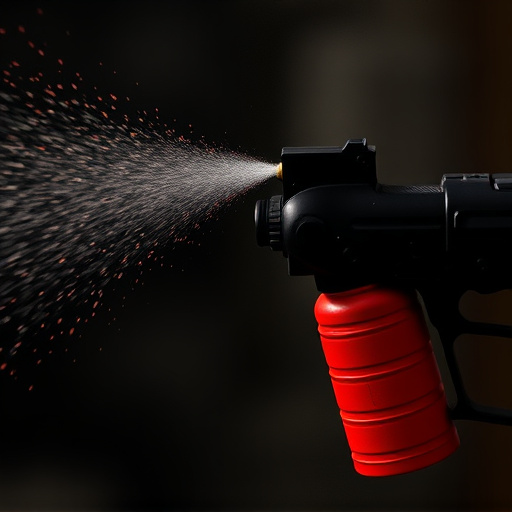To legally carry pepper spray, research local laws and regulations on possession, use, and carrier restrictions, focusing on type, capacity, permissible scenarios, and "stand-your-ground" rules. Understand delivery systems (stream, mist, aerosol) for specific needs, and check with local law enforcement for compliance with permits, registration, and canister limits. Familiarize yourself with regional guidelines, "no-carry" zones, background checks, training requirements, and responsible handling practices to enhance personal safety while adhering to legal constraints.
“Uncover the power of self-defense with a tactical grade pepper spray dispenser. In today’s uncertain world, understanding how to legally carry pepper spray is crucial. This comprehensive guide explores everything from navigating diverse pepper spray laws and choosing the right dispenser to mastering effective use and safety tips. Learn about legal carry requirements, permits, and regulations, ensuring you stay within the boundaries of the law while empowering yourself with this potent tool. Dive into these essential insights on how to legally carry pepper spray for peace of mind.”
- Understanding Pepper Spray Laws: A Comprehensive Guide
- Choosing the Right Tactical Dispenser for Your Needs
- Legal Carry Requirements: Permits and Regulations Explained
- Effective Use and Safety Tips for Pepper Spray Dispensers
Understanding Pepper Spray Laws: A Comprehensive Guide
Before considering how to legally carry pepper spray, understanding the laws surrounding its possession and use is paramount. Laws regarding pepper spray vary greatly from one jurisdiction to another, with some states or regions having more stringent regulations than others. For instance, some areas require a permit to own pepper spray, while others mandate specific types of training or registration. Knowing and adhering to these local laws is crucial to avoid legal repercussions.
To legally carry pepper spray, start by researching your state’s or province’s legislation on the subject. Check for any restrictions on the type, capacity, and amount of pepper spray you can possess. Also, be aware of where and when it’s permissible to use pepper spray. Some places have explicit rules about self-defence and whether pepper spray can be employed in such situations. Ensure you’re well-versed in these regulations to make informed decisions regarding your personal safety while staying within the legal boundaries.
Choosing the Right Tactical Dispenser for Your Needs
Choosing the right tactical pepper spray dispenser involves understanding your specific needs and legal considerations. Different dispensers offer various features such as stream, mist, or aerosol delivery systems, each suited for different scenarios. For close-quarters encounters, a stream pattern may be effective in temporarily incapacitating an attacker. Conversely, a mist setting provides a wider coverage area, ideal for crowded spaces or outdoor situations where you need to protect yourself from multiple threats.
Moreover, legal restrictions vary by location on how and where pepper spray can be carried. Understanding local laws regarding self-defense tools is crucial before making a purchase. Some jurisdictions require permits or registration for tactical pepper spray, while others have strict limits on the amount of oleoresin capsicum (OC) allowed in a canister. Always check with your local law enforcement agency to ensure you’re complying with how to legally carry pepper spray responsibly and effectively.
Legal Carry Requirements: Permits and Regulations Explained
Knowing how to legally carry pepper spray is essential for personal safety and self-defense. The first step involves understanding regional laws, as regulations vary widely from one location to another. Some areas require individuals to obtain a permit or license to possess and carry pepper spray, while others may have restrictions on the type and amount of spray allowed. It’s crucial to check with local law enforcement agencies or government websites for specific guidelines in your region.
Permits often involve background checks and training requirements. Once obtained, there are still rules to follow when carrying the spray. This includes understanding “stand-your-ground” laws, which dictate when and where self-defense actions, including the use of pepper spray, are justified. Additionally, being aware of “no-carry” zones, such as schools, government buildings, or airports, is vital to ensure compliance with local regulations and avoid legal repercussions for illegal carry.
Effective Use and Safety Tips for Pepper Spray Dispensers
Carrying pepper spray can be a powerful tool for personal safety, but it comes with responsibilities and guidelines. To ensure its effective use and legal carrying, individuals should familiarize themselves with local laws and regulations regarding pepper spray ownership and usage. Understanding the specific rules in your area is crucial, as restrictions vary significantly from place to place.
Safety tips include practicing responsible handling, keeping the dispenser in a secure location, and ensuring it’s easily accessible during an emergency. Regular maintenance, such as checking expiration dates and testing spray functionality, is vital. Users should also be trained in proper usage techniques, including target areas, distance considerations, and de-escalation strategies. Knowing how to legally carry pepper spray is not just about accessibility; it’s about being prepared while adhering to the law.
In conclusion, a tactical grade pepper spray dispenser can be a powerful tool for personal safety when used correctly. Understanding local laws, choosing the right device, and learning safe handling practices are essential steps in ensuring you’re prepared while adhering to legal carry requirements. Remember, knowing How to Legally Carry Pepper Spray responsibly is key to protecting yourself and your loved ones.
